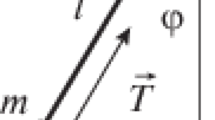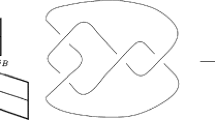Abstract
This text is a continuation of the overview “Knot polynomials from \(\mathcal{R}\)-matrices: where is physics?” (Phys. Part. Nucl. 51, 172 (2020)). We continue to discuss the basics of a popular subject in modern mathematical physics: describing knots by means of \(\mathcal{R}\)-matrix polynomials. Having discussed the physical context, we now focus on the mathematical apparatus, in which topology, the theory of integrable systems, and the representation theory of quantum groups are intertwined. This text is intended as an introduction to the subject for all those interested in this topic.





















Similar content being viewed by others
Notes
A group representation is a set of linear operators (acting in the representation space, which is linear) corresponding to its elements so that the composition of operators corresponds to the product of elements; after choosing a basis in the representation space, the operators (representation elements) can be written in matrix form.
The representation of an algebra differs from the representation of a group (see above) by an additional condition: a linear combination of elements of the algebra corresponds to the same linear combination of their matrices in the representation.
This property is somewhat modified, depending on the chosen normalization of invariants [28].
In the case of general position of parameters \(\lambda \) and \(\mu \) [32] (see Section 6.3.3).
If both off-diagonal elements in a \(2 \times 2\) matrix \(A\) are nonzero, then changing the basis with the matrix \(V = {\text{diag}}(x,{{x}^{{ - 1}}})\), where \(x = \sqrt {A_{{2,1}}^{{ - 1}}{{A}_{{12}}}} \), will give a symmetric matrix \({{V}^{{ - 1}}}AV\).
The correctness of this definition is discussed in Section 4.
Note the difference in the definitions of direct and inverse twisted matrices: the first is obtained by permuting a pair of superscripts and the second is obtained by permuting a pair of subscripts. The reason for this agreement will be clarified in Section 5.2.
Sequential writing of the equations for \(i = N,N - 1, \ldots ,1\) gives a linear system with a triangular matrix.
With one essential supplement, to which Section 4.3.3 is devoted.
The author is grateful to Andrei Smirnov for pointing out this fact.
Each of the matrices \({{R}_{1}}\) and \({{R}_{2}}\) on such a subspace must have two different eigenvalues, otherwise the matrices commute and are diagonalized simultaneously.
See commentary in Section 6.1.3.
More precisely, all Lie algebras included in the Cartan classification [31].
REFERENCES
L. H. Kauffman, The Interface of Knots and Physics (World Scientific, Singapore, 2001).
R. J. Baxter, Exactly Solved Models in Planar Mechanics (Acad. Press, London, 1989).
N. Yu. Reshetikhin, L. A. Takhtadzhyan, and L. D. Faddeev, “Quantization of Lie groups and Lie algebras,” Algebra Anal. 1, 178–206 (1989).
E. Demidov, Quantum Groups (Factorial, Moscow, 1998) [in Russian]; http://fot.pskgu.ru/ebooks/demidoval.html.
V. O. Manturov, Knot Theory (Institut Komp’yuternykh Issledovanij, Moscow–Izhevsk, 2005) [in Russian].
D. Bar-Natan, M. Scott, et al., The Knot Atlas, http://katlas.org.
J. W. Alexander, “Topological invariants of knots and links,” Trans. AMS 30, 275–306 (1928).
S. Chmutov, S. Duzhin, and J. Mostovoy, Introduction to Vassiliev Knot Invariants (Cambridge Univ. Press, 2012).
V. F. R. Jones, “A polynomial invariant for knots via von Neumann algebra,” Bull. AMS 12, 103–111 (1985).
P. Freyd, D. Yetter, J. Hoste, W. B. R. Lickorish, K. Millett, and A. Ocneanu, “A new polynomial invariant of knots and links,” Bull. AMS 12, 239–246 (1985).
J. H. Przytycki and P. Traczyk, “Invariants of links of Conway type,” Kobe J. Math. 4, 115–139 (1988).
B. H. Kwon, “On the HOMFLY polynomial of 4-plat presentations of knots” (2013), arXiv:1309.5052.
L. Kauffman, “State models and the Jones polynomial,” Topology 26, 395–407 (1987).
H. R. Morton and H. J. Ryder, “Mutants and \(su{{(3)}_{q}}\) invariants,” Geom. Topol. Monogr. 1, 365–381 (1998).
A. S. Anokhina and A. A. Morozov, “Cabling procedure for the colored HOMFLY polynomials,” Theor. Math. Phys. 178, 1–58 (2014); arXiv:1307.2216.
S. Nawata, P. Ramadevi, and V. K. Singh, “Colored HOMFLY polynomials can distinguish mutant knots” (2015), arXiv:1504.00364.
L. Bishler, S. Dhara, T. Grigoryev, A. Mironov, A. Morozov, An. Morozov, P. Ramadevi, V. K. Singh, and A. Sleptsov, “Distinguishing mutant knots” (2020), arXiv:2007.12532.
A. S. Anokhina, “Knot polynomials from \(\mathcal{R}\)-matrices: Where is physics?,” Phys. Part. Nucl. 51, 172–219 (2020).
N. Y. Reshetikhin and V. G. Turaev, “Ribbon graphs and their invariants derived from quantum groups,” Commun. Math. Phys. 127, 1–26 (1990).
R. K. Kaul, “Chern-Simons theory, colored-oriented braids and link invariants,” Commun. Math. Phys. 162, 289–320 (1994); arXiv:hep-th/9305032.
M. Khovanov, “A categorification of the Jones polynomial,” Duke Math. J. 101, 359–426 (2000); arXiv: 9305032.
N. M. Dunfield, S. Gukov, and J. Rasmussen, “The superpolynomial for knot homologies,” Exp. Math. 15, 129–159 (2006); arXiv:0505662.
D. Bar-Natan, “On the Vassiliev knot invariants,” Topology 34, 423–472 (1995).
D. Bonatsos and C. Daskaloyannis, “Quantum groups and their applications in nuclear physics,” Prog. Part. Nucl. Phys. 43, 537–618 (1999); arXiv:9909003.
A. Yu. Morozov, “Unitary integrals and related matrix models,” Theor. Math. Phys. 162, 1–33 (2010); arXiv: 0906.3518.
A. Yu. Morozov, “Integrability and matrix models,” Phys.-Usp. 37, 1–55 (1994).
C. T. Chan, A. Mironov, A. Morozov, and A. Sleptsov, “Orthogonal polynomials in mathematical physics,” Rev. Math. Phys. 30 (6), 1840005 (2018); arXiv: 1712.03155.
A. Mironov, A. Morozov, and And. Morozov, “Character expansion for HOMFLY polynomials. II. Fundamental representation. Up to five strands in braid,” J. High Energy Phys., No. 03, 034 (2012).
D. Shapiro, Representations of Groups and Their Application in Physics (KTF Novosib. Gos. Univ., Novosibirsk, 2004); http://ind.pskgu.ru/ebooks/shapirodaal2.html.
A. P. Isaev and V. A. Rubakov, Group and Symmetry Theory (URSS, Moscow, 2018); http://ind.pskgu.ru/ebooks/shapirodaal2.html.
H. Georgi, Lie Algebras in Particle Physics. From Isospin to Unified Theories (Westview Press, Boulder, 1999).
V. F. R. Jones, “Hecke algebra representations of braid groups and link polynomials,” Ann. Math. 126, 335–388 (1989).
V. G. Drinfel’d, “Quantum groups,” Zapiski Nauchnogo Seminara LOMI 155, 18–49 (1986).
P. D. Francesco, P. Mathieu, and D. Sénéchal, Conformal Field Theory (Springer, New York, 1997).
A. N. Kirillov and N. Reshetikhin, “q-Weyl group and a multiplicative formula for universal R-matrices,” Commun. Math. Phys. 134, 527–533 (1990).
M. Rosso and V. Jones, “On the invariants of torus knots derived from quantum groups,” J. Knot Theory Its Ramifications 2, 97–112 (1993).
M. Jimbo, “A q-analogue of \({{U}_{q}}(gl(N + 1))\), Hecke algebra and the Yang–Baxter equation,” Lett. Math. Phys. 11, 247–252 (1986).
V. G. Turaev, “The Yang-Baxter equation and invariants of links,” Invent. Math. 92, 527–533 (1988).
A. Morozov and A. Smirnov, “Chern-Simons theory in the temporal gauge and knot invariants through the universal quantum R-matrix,” Nucl. Phys. B 835, 284–313 (2010); arXiv:1001.2003.
A. N. Kirillov and N. Y. Reshetikhin, “Representations of the algebra \({{U}_{q}}(sl(2))\), \(q\)-orthogonal polynomials and invariants of links,” in Infinite Dimensional Lie Algebras and Groups (World Scientific, Singapore, 1989), pp. 285–339; https://math.berkeley.edu/ reshetik/Publications/q6j-KR.pdf.
M. Khovanov and L. Rozansky, “Matrix factorizations and link homology,” Fundam. Math. 199, 1–91 (2008); arXiv:0401268.
P. Ramadevi, T. Govindarajan, and R. Kaul, “Knot invariants from rational conformal field theories,” Nucl. Phys. B 422, 291–306 (1994); arXiv:9312215.
O. Alekseev and F. Novaes, “Wilson loop invariants from \({{W}_{N}}\) conformal blocks,” Nucl. Phys. B 901, 461–479; arXiv:1505.06221.
A. J. Bracken, M. D. Gould, and R. B. Zhang, “Quantum group invariants and link polynomials,” Commun. Math. Phys. 137, 13–21 (1991).
A. Mironov and A. Morozov, “Universal Racah matrices and adjoint knot polynomials. I. Arborescent knots,” Phys. Lett. B 755, 47—57 (2016); arXiv: 1511.09077.
D. M. Galakhov, A. D. Mironov, and A. Yu. Morozov, “SU(2)/SL(2) knot invariants and Kontsevich–Soibelman monodromies,” Theor. Math. Phys. 187, 678–694 (187); arXiv:1510.05366.
D. Galakhov, D. Melnikov, A. Mironov, and A. Morozov, “Knot invariants from Virasoro related representation and pretzel knots,” Nucl. Phys. B 899, 194–228 (2015); arXiv:1502.02621.
A. Sleptsov, “Hidden structures of knot invariants,” Int. J. Mod. Phys. A 29, No 29, 1430063 (2014).
A. Morozov and A. Sleptsov, et al., The knotebook, https://www.knotebook.org.
M. D. Gould and Y. Z. Zhang, “Quantum affine Lie Algebras, Casimir invariants and diagonalization of the braid generator,” J. Math. Phys. 35, 6757–6773 (1994); arXiv:9311041.
S. Dhara, A. Mironov, A. Morozov, A. Morozov, P. Ramadevi, V. K. Singh, and A. Sleptsov, “Multi-colored links from 3-strand braids carrying arbitrary symmetric representations,” Ann. Henri Poincare 20, 4033–4054 (2019); arXiv:1805.03916.
A. Mironov, A. Morozov, A. Morozov, and A. Sleptsov, “Racah matrices and hidden integrability in evolution of knots,” Phys. Lett. B 760, 45–58; arXiv:1605.04881.
C. Bai, J. Jiang, J. Liang, A. Mironov, A. Morozov, A. Morozov, and A. Sleptsov, “Quantum Racah matrices up to level 3 and multicolored link invariants,” J. Geom. Phys. 132, 155–180 (2018); arXiv: 1801.09363.
A. Mironov, A. Morozov, A. Morozov, and A. Sleptsov, “Quantum Racah matrices and 3-strand braids in irreps R with |R| = 4,” JETP Lett. 104, 56–61 (2016); arXiv: 1605.03098.
H. J. Jie Gu, “A note on colored HOMFLY polynomials for hyperbolic knots from WZW models,” Commun. Math. Phys. 338, 393–456 (2015); arXiv:1407.5643.
A. Mironov, A. Morozov, A. Morozov, P. Ramadevi, V. K. Singh, and A. Sleptsov, “Tabulating knot polynomials for arborescent knots,” J. Phys. A: Math. Theor. 50, 085201 (2017); arXiv:1601.04199.
L. Bishler, A. Morozov, A. Sleptsov, and S. Shakirov, “On the block structure of the quantum R-matrix in the three-strand braids,” Int. J. Mod. Phys. A 33, No 17, 1850105 (2018); arXiv:1712.07034.
S. Dhara, A. Mironov, A. Morozov, A. Morozov, P. Ramadevi, V. K. Singh, and A. Sleptsov, “Eigenvalue hypothesis for multi-strand braids,” Phys. Rev. D 97, 126015 (2018); arXiv:1711.10952.
And. Morozov and A. Sleptsov, “New symmetries for the \({{u}_{q}}(s{{l}_{n}})\) 6-j symbols from the eigenvalue conjecture,” JETP Lett. 108, 697–704 (2018); arXiv:1905.01876.
V. Alekseev, And. Morozov, and A. Sleptsov, “Interplay between symmetries of quantum 6-j symbols and the eigenvalue hypothesis” (2019); arXiv:1909.07601.
A. Klimyk and K. Schmüdgen, Quantum Groups and Their Representations (Springer, Berlin–Heidelberg, 2012).
Ya. Kononov and A. Morozov, “Factorization of colored knot polynomials at roots of unity,” Phys. Lett. B 747, 500–510; arXiv:1505.06170.
F. Calegari, S. Garoufalidis, and D. Zagier, “Bloch groups, algebraic K-theory, units, and Nahm’s conjecture” (2017), arXiv:1712.04887.
ACKNOWLEDGMENTS
I am grateful to A.Yu. Morozov and A.D. Mironov for many years of painstaking scientific guidance of my scientific work, and also to E.S. Suslova and V.V. Sleptsova (Nasonova) for creating conditions for it. I am grateful to E.T. Akhmedov, P.I. Dunin-Barkovskii, D.V. Vasil’ev, E.A. Vyrodov, D.V. Galakhov, A.A. Morozov, A.Yu. Orlov, I.V. Polyubin, A.V. Popolitov, A.A. Roslom, and A.V. Sleptsov for their interest in the work, careful reading of the drafts to this text, and numerous critical comments. I am also grateful to N.Ya. Amburg, G.B. Aminov, S.B. Artamonov, I.A. Danilenko, A.V. Zabrodin, O.S. Kruglinskaya, N.A. Nemkov, S.A. Mironov, Sh.R. Shakirov and other participants of the seminar of the Laboratory of Methods of Mathematical Physics at the Institute for Theoretical and Experimental Physics (ITEP) for regular fascinating and useful discussions. I am also grateful to I.V. Tyutin for a detailed analysis of the introductory example.
I am especially grateful to I.A. Dynnikov, A.V. Malyutin, and M.E. Kazaryan for their deep attention to the author’s work and valuable discussions.
I am grateful to E.T. Akhmedov, M.I. Vysotskii, A.V. Marshakov, V.A. Novikov, T.V. Uglov, and other organizers of the ITEP youth conference for the opportunity to speak to a new, diverse, and attentive audience.
I am also grateful to the people who opened my way to science, in particular, A.A. Abrikosov, D.A. Aleksandrov, M.V. Danilov, N.V.Z. Nozik, N. Ostrikov, V.P. Slobodyanin, T.V. Uglov, V.V. Shan’kov, and S.A. Sharakin.
Funding
This work was supported by the Russian Science Foundation, grant no. 16-12-10344.
Author information
Authors and Affiliations
Corresponding author
Additional information
Translated by E. Chernokozhin
Rights and permissions
About this article
Cite this article
Anokhina, A.S. Knot Polynomials from \(\mathcal{R}\)-Matrices: Wherefore This Mathematics?. Phys. Part. Nuclei 52, 374–419 (2021). https://doi.org/10.1134/S1063779621030023
Received:
Revised:
Accepted:
Published:
Issue Date:
DOI: https://doi.org/10.1134/S1063779621030023




